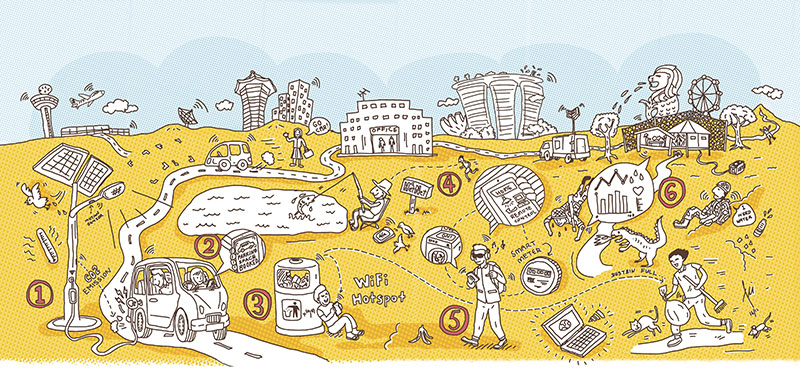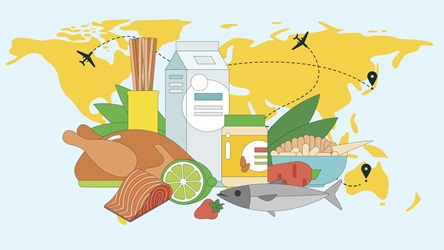How Will Sensors Connecting Objects Change Public Services?

1. ALL-IN-ONE LAMP POSTS
Is it a lamp post, a charging station or a sensor? In the future, it could be all three and more. Various countries are testing these all-in-one lamp posts that tap solar power to run an extensive network of sensors, power electric cars or mobile phones, and even send out Wi-Fi signals. In Singapore, the Aggregation Gateway Box will consolidate all government agencies’ sensor needs while providing Internet connectivity and power for the sensors. These sensors could include those that measure air quality, temperature, noise levels and carbon dioxide emissions, as well as sensors that detect movement and adjust lighting intensities to save energy.
2. STRESS-FREE PARKING
Nobody enjoys the hunt for a prized carpark lot, especially during peak hours. Several cities, including Singapore, have begun to roll out smarter parking by installing Internet-connected sensors at carparks. These sensors send out real-time information to drivers via smartphone apps to show exactly where the empty lots are. This cuts down on idling and pollution, smoothening traffic. In some cities, drivers can already pre-book lots and extend their sessions remotely. In the future, carpark rates could be adjusted to demand while underutilised lots, e.g. season parking lots, could be freed up during off-peak hours. With driverless cars, passengers could even alight at their offices’ front doors and leave their cars to “talk” to nearby empty lots before self-navigating to carpark heaven. Sweet.
3. THE BIN WILL NEVER RUNNETH OVER
The idea of a dustbin paired with a sensor that alerts cleaners when it is nearly full sounds like a no-brainer, right? The National Environment Agency plans to install sensors for more than 8,000 bins islandwide. Of course, these bins are smart only when rubbish is thrown inside them. In New York City, some smart bins are even doubling as wireless hotspots.
4. INTERNET EVERYWHERE
To experience the full “magic” of IoT with sensors always connected, a seamless high-speed Internet connection is needed. Singapore is creating an islandwide HetNet – or heterogenous network – that will allow users from any telco to hop across 4G or Wi-Fi networks without disruption. This is undergoing trials in Jurong Lake District.
5. MICROMANAGE ENERGY USAGE
Getting people to reduce their energy consumption should get easier in the future when the energy consumption of Internet-linked appliances is closely tracked via a Smart Meter, and reported onto a “dashboard” in their smartphone apps. They can scrutinise which appliance has been an energy hog, or which washing machine setting just saved them money. The hope is that the immediate feedback would nudge consumers to adjust their energy usage. In fact, Smart Meters can alert users to the varying energy prices throughout the day via their smartphones, spurring them to check their usage and enabling them to control their appliances remotely. Of course, there’ll never be the worry of “Did I turn off the gas or the lights?” again.
6. INTERNET-ENHANCED COMBAT
If you had watched Jurassic World, you would have seen how the armed security guards – outfitted with sensors that relayed real-time vital signs – were easily monitored by the command centre. This isn’t a farfetched scenario for militaries of the future as research is underway to create mini sensors so thin they can be embedded into adhesive bandages and stuck onto skin like temporary tattoos. These sensors will collect and transmit data such as body temperature, heart rates, respiration rates and hydration levels.
Researchers are also looking into weaving fibre optics into uniforms to create a network of multi-use sensors that identify soldiers exposed to biological attacks, determining the extent and severity of a wound, or even help to detect allies more easily. Already, the Singapore army has the Basic Fighting System (BFS) – a wearable digital system that helps soldiers to track friendly and hostile forces with the help of remote sensors. A lightweight version, called the iLite, that weighs a third of the BFS, was launched in 2014.
All these IoT-enabled tech sound ideal, but with all the data flowing through the Internet, keeping the network secure from hackers will be another headache for the military. Also, there’s the question of how to ensure that the network is always “up” even during a war.
- POSTED ON
Jan 4, 2016
- TEXT BY
Bridgette See
-
Deep Dive
Strengthening Singapore’s Food Security
-
Deep Dive
Say Hello To The Internet Of Things









.tmb-tmb450x250.jpg)